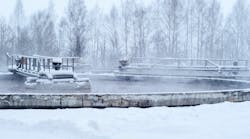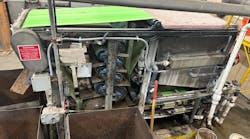Thirty-three years after enactment of the nation’s Clean Water Act, America has improved its water quality by just about any measure: pounds of pollution abated, stream segments improved, fisheries restored. Today, twice as many Americans are served by advanced or secondary wastewater treatment. We are actually closing in on no-net-loss of wetlands. Lake Erie, once declared dead, is a walleye fisherman’s Mecca.
Yet, we seem to be stuck on a plateau. We detect a certain flattening out of the upward curve of progress as we confront seemingly intractable problems. We find ourselves in the midst of a storm of challenges to the National Water Program, which are rooted in the law itself and evolving circumstances over time. We have no legal regime or comprehensive, non-regulatory program in place to address diffuse, polluted runoff, so-called nonpoint source pollution. We have inadequate or nonexistent water quality standards in place for some key parameters, especially nutrients. We confront a seeming inability, in institutional terms, to focus on the entire watershed as the big picture. And we lack a scientifically defensible ambient water quality monitoring program at the national level.
Pollution sources
Just about any human activity on the land can generate polluted runoff. Lawn fertilizer, paving of impervious surfaces, row crop agriculture, construction activities and golf courses, are some of the nonpoint sources of contaminants such as sediment, nutrients and pesticides.
Thirty-nine percent of assessed river miles, 45% of assessed lake acres and 51% of assessed estuary square miles are “impaired.” That is, they are not meeting water quality standards, which are based on designated uses, such as fishing, swimming and drinking water use.
Urban storm water runoff from streets, parking lots and sidewalks is a leading cause of impairment for nearly 40% of surveyed water bodies. While subject to regulation and permitting, these sources are difficult to control and monitor given their number and distribution.
The hypoxic zone in the Gulf of Mexico (“the Dead Zone”) keeps getting larger. Forward momentum on the cleanup of Chesapeake Bay is sluggish. Both of these bodies of water are polluted, significantly, by runoff from agriculture, essentially nonpoint sources, which is not subject to regulation under the Clean Water Act.
Tens of thousands of inland lakes in New England and the upper Midwest, along with rivers in the Southeast, are the subject of fish consumption advisories for mercury which, primarily, falls from the sky. A quarter of the total nitrogen load to the Chesapeake Bay comes from the air, 75% falling on land and then running off into the water.
Clear direction
For nearly three decades, EPA’s National Water Program, at the clear direction of Congress, focused almost exclusively on the big industrial and municipal discharge pipes in the water. These are the traditional point source dischargers, which have been successfully controlled through the National Pollutant Discharge Elimination System (NPDES) permitting program.
EPA imposed categorical, technology-based effluent guidelines on these point source dischargers at the end of the pipe, without regard to the quality of the receiving waters.
The law was: “Just do it!” No paralysis by analysis and no calibrating of the discharge to the ambient water quality. The guidelines may or may not achieve water quality standards and criteria, assuming they are in place. Monitoring was done, predominantly, at the end of the pipe, for compliance purposes, rather than for assessing general ambient water quality in the watershed or stream segment as a whole.
Technology-based effluent guidelines have now reached the point of diminishing returns in terms of practicability and economic achievability required by law. Moreover, an increasing number of receiving waters already have water quality standards in place for which the guidelines will be inadequate.
If, in a permitting cycle (every five years), a permit writer finds that technology-based permit limits are not stringent enough to meet water quality standards, water quality-based effluent limits must be imposed. These involve a site-specific evaluation of the discharge and its effect on the receiving water.
It is hard to appreciate how all-consuming was the effort to develop technology-based effluent guidelines. For decades this was the focal point of so much of EPA’s activities requiring enormous amounts of resources, personnel and budget. The courts basically dictated the workload pursuant to successful lawsuits filed by environmentalists. Industry, in turn, filed numerous lawsuits of their own challenging the guidelines promulgated by EPA. For instance, by 1976, there were already 250 lawsuits on file challenging specific guidelines.
EPA has recently attempted to gain control of its resources by proposing a more balanced and modest Effluent Guidelines Plan to meet its statutory obligations to continually review, develop and update such guidelines while allowing for other pressing priorities such as refining water quality standards. I had redeployed 20 staff from effluent guidelines into water quality standards work and other functions while serving as assistant administrator for water at EPA.
The crucial element
The Total Maximum Daily Load (TMDL) program is a crucial element in the age of the watershed. The TMDL program was in the Clean Water Act from the beginning, but it was neglected by EPA in its struggle to meet legislative mandates for point source discharges. A wave of litigation in the mid-1990s energized this program.
A TMDL is, essentially, a pollution limit for impaired waters which establishes waste load allocations for individual point source dischargers to be met in their NPDES permits. It also sets a load allocation for categories of nonpoint sources throughout the watershed or drainage. These load allocations are more informational, designed to direct and drive local and regional efforts, primarily voluntary or financial.
A TMDL is only as good as the water quality standards upon which it is based. If the standards are inappropriate, e.g., too lenient or too strict (or unattainable), the TMDL will be flawed. It is important that technically defensible water quality standards are in place to guide the development of a TMDL and provide the performance measure for watershed cleanup activities for both point and nonpoint sources.
It cannot be emphasized too much that the watershed, not the discrete discharge, should be the scale at which Clean Water Act programs should be implemented. This, in turn, requires broad stakeholder participation and empowerment, hydrologically defined boundaries, and coordinated management. Watershed-based permitting and water quality trading are useful vehicles for more flexible, result-oriented approaches to achieving water quality objectives in this fashion.
In 2003, we issued EPA’s guidance on watershed-based permitting allowing for the development of discharge permits for multiple sources in a watershed. It considers watershed goals and the effect of multiple sources and stressors, including nonpoint source contributions. This synchronized approach to permitting offers numerous advantages such as administrative and program efficiencies; a means of implementing cost-effective technologies and management practices, including water quality trading; integrating watershed management across federal statutes such as the Safe Drinking Water Act and the Endangered Species Act; and encouraging early and meaningful collaboration and cooperation among key stakeholders.
A complementary tool is EPA’s new Water Quality Trading Policy which we also released in 2003. The policy allows one source to meet its regulatory obligations by using pollutant reductions created by another source at lower cost. It contemplates trading between point sources and between point and nonpoint sources as well. Besides pollutant load reductions, it seeks to encourage ancillary environmental benefits such as habitat restoration through low-cost management practices on the land which also reduce, say, nutrient runoff.
In terms of a broader watershed focus, ambient water quality monitoring is critical. Water quality monitoring and assessment programs in this country are at a historic turning point.
Water conditions
We have collected data of all types and sources. Nevertheless, we cannot describe in a scientifically defensible way, the quality of our waters at a national level. We do not know the condition of the majority of states’ waters. We cannot quantify progress we have made to date in cleaning those waters, nor where we need to go to fix remaining problems. We are flying blind when it comes to making decisions about how best to address water quality problems and allocate our limited resources for cleanup, pollution prevention and restoration.
Because state water quality standards and assessment methods vary, we cannot add up the existing state data to get a clear picture of how well our national programs are working.
These are tight budget times in Washington. But given the nation’s need to broaden its focus to encompass the entire watershed and to address the myriad challenges to water quality, it is essential for the federal government to get the standards right and to adequately monitor progress, or lack thereof, in achieving those standards.
EPA should establish the end points of performance and then inform all the stakeholders—local, state and federal—of their success or lack thereof in achieving them. This information will inform the political process, generating new resources, or directing existing resources and authorities into the most cost-effective actions.
EPA is entering a new era under the Clean Water Act representing a shift from technology-based approaches to those focused on water quality at the watershed scale. Building upon the foundation of the NPDES program and the technology-based effluent guidelines, EPA must continue to emphasize nonpoint sources as much as point sources; water quality standards as much as technology-based guidelines; the entire watershed as much as the discrete discharge pipe; and ambient water quality monitoring as much as monitoring end of pipe exclusively for point source compliance purposes.

